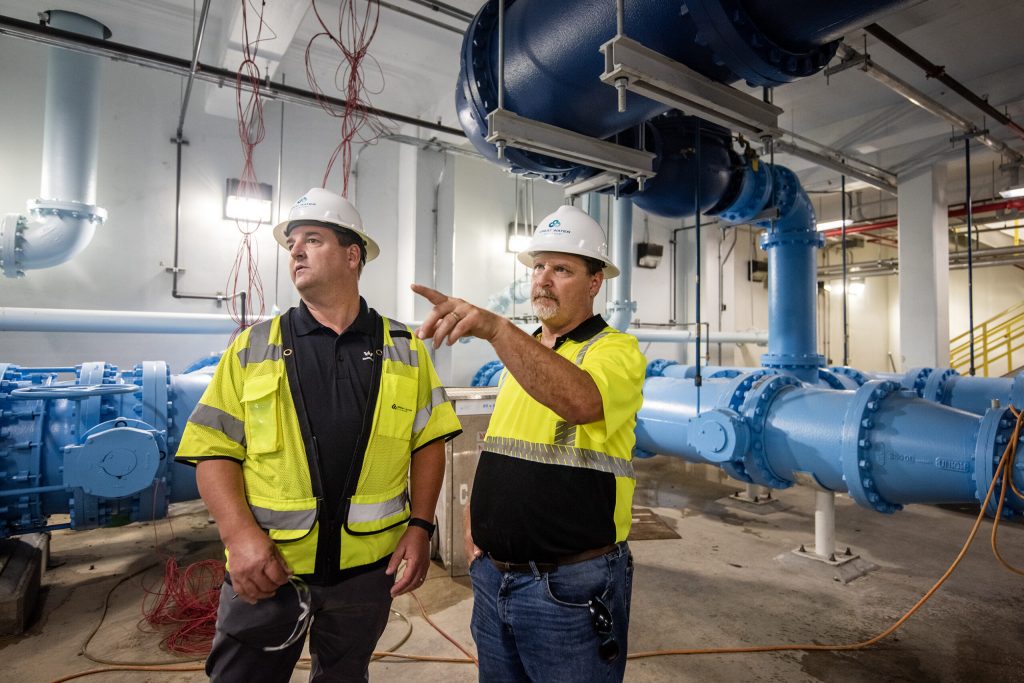Wisconsin Had Record-High Construction Jobs in January
Several factors cited, including warm weather and boom in federally funded projects.

General manager of Waukesha’s Water Utility Dan Duchniak, left, walks around the facility with Jeff Champion, a construction manager with Black & Veatch, right, on Tuesday, Aug. 29, 2023, in Waukesha, Wis. Angela Major/WPR
Wisconsin set a new record high for the number of construction jobs in the state, reaching that milestone in January months before the construction season typically begins.
Data released Thursday by the state Department of Workforce Development showed the construction industry added 1,900 workers in the first month of the year. That brought the state to a record high 140,000 construction trade jobs. Wisconsin’s typical construction season runs from April through November.
Economists, the state builders association and construction unions said the industry’s job growth could be tied to several factors. They cited Wisconsin’s unseasonably warm winter, stabilizing interest rates, a national construction boom and federal investments in the state’s infrastructure.
“Generally speaking, in cold weather, you see a drop in construction,” said Dennis Winters, chief economist for DWD. “We’ve had some fairly mild weather by comparison over the last month or so (and), certainly, into January.”
Winters said he expects the momentum in the construction sector to continue, especially if interest rates come down and home building becomes more affordable.
Menzie Chinn, a macroeconomist at the University of Wisconsin-Madison, said the rise in state construction employment may be tied to a larger national construction boom.
In January, construction spending nationally totaled $2.1 trillion at a seasonally adjusted annual rate, according to the Associated General Contractors of America. That’s down 0.2 percent from the previous month but 11.7 percent higher than in the same month of 2023.
Construction employment nationally has been on a steady upward trend since May 2020, and it’s increased in each of the last three months, according to data from the Federal Reserve Bank of St. Louis.
Chinn said about one-fifth of the change in employment for January and February is tied to nonresidential construction.
“There’s a big boom in the building of commercial (properties). Not commercial as in stores, but factories,” he said. “I don’t know how much of that is in Wisconsin, but nationwide, that’s a very big factor. There’s a lot of construction going on.”
Anthony Anastasi, business agent for the Iron Workers Local 383 union based in Madison, said federal investments like the Inflation Reduction Act and the bipartisan infrastructure law have also factored into the increase in state construction jobs.
“That has allowed the opportunities to rebuild our infrastructure that has always been needed,” Anastasi said of the recent federal laws. “It’s hard for us as citizens of the state to get from (point) A to B, and care for our families if we don’t have that updated and proper infrastructure.”
In 2021, the White House estimated Wisconsin would receive $5.2 billion for highway programs and $225 million for bridges over five years from the bipartisan infrastructure law. In January, the Biden administration announced an additional $1 billion investment toward replacing the Blatnik Bridge connecting Superior and Duluth.
Anastasi added that jobs in construction, especially in union-represented trades, generally pay well.
“It allows (workers) the time and financial resources to turn around and take care of the other things that are important to their family, like coaching their son or daughter’s ball team, volunteering at their local church or volunteering at a fishing event,” he said.
In a statement, Alicia Naleid, communications director for the Wisconsin Builders Association, said new home construction ticked up slightly last year. As mortgage rates either hold steady or drop, Naleid said bigger projects and apartments that were on hold are coming back online, creating continued need for construction workers.
“Even though the numbers appear positive, there is still a shortage of workers in almost every segment of construction and trades,” she said. “Demand is still strong and is forecasted to remain strong for several years.”
Beyond the construction industry, the state also had a record 3.05 million Wisconsinites employed in January, while the state’s unemployment rate remained near record lows at 3.2 percent, according to the DWD.
To start the year, Wisconsin also set a new record of 3.03 million total nonfarm jobs and 2.6 million private sector jobs, according to DWD.
“All indicators are that Wisconsin is still doing pretty well in terms of the labor market,” said Chinn, the economist at UW-Madison.
Wisconsin had record-high construction jobs in January was originally published by Wisconsin Public Radio.






















Mr. Schulz, why not include any pay discrimination facts in this article, or at a minimum question the union leaders and industry representatives you interviewed in this article about the issue?
With their industry seeking out of workers to fill their need, they’d likely provide some real works insight.